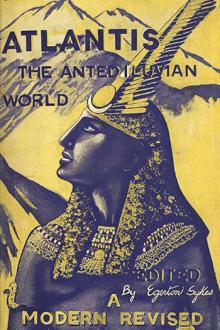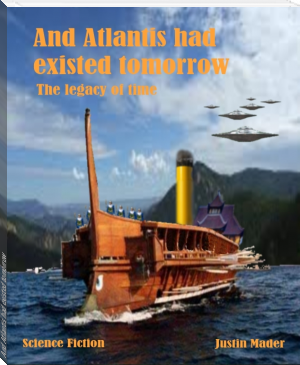Atlantis: The Antedeluvian World by Ignatius Donnelly (thriller novels to read .TXT) 📕

- Author: Ignatius Donnelly
- Performer: -
Book online «Atlantis: The Antedeluvian World by Ignatius Donnelly (thriller novels to read .TXT) 📕». Author Ignatius Donnelly
“He rode upon a tornado, and scattered the lightnings.” (Dorman, “Prim.
Superst.,” p. 98.)
Dionysus, or Bacchus, is represented by the Mexican god Texcatzoncatl, the god of wine. (Bancroft, vol. iii., p. 418.) Atlas reappears in Chibchacum, the deity of the Chibchas; he bears the world on his shoulders, and when be shifts the burden from one shoulder to another severe earthquakes are produced. (Bollært, pp. 12, 13.) Deucalion repeopling the world is repeated in Xololt, who, after the destruction of the world, descended to Mictlan, the realm of the dead, and brought thence a bone of the perished race. This, sprinkled with blood, grew into a youth, the father of the present race. The Quiche hero-gods, Hunaphu and Xblanque, died; their bodies were burnt, their bones ground to powder and thrown into the waters, whereupon they changed into handsome youths, with the same features as before. (Dorman, “Prim. Superst.,” p. 193.)
Witches and warlocks, mermaids and mermen, are part of the mythology of the American tribes, as they were of the European races. (Ibid., p. 79.) The mermaid of the Ottawas was “woman to the waist and fair;” thence fish-like. (Ibid., p. 278.)
The snake-locks of Medusa are represented in the snake-locks of At-otarho, an ancient culture-hero of the Iroquois.
A belief in the incarnation of gods in men, and the physical translation of heroes to heaven, is part of the mythology of the Hindoos and the American races. Hiawatha, we are told, rose to heaven in the presence of the multitude, and vanished from sight in the midst of sweet music.
The vocal statues and oracles of Egypt and Greece were duplicated in America. In Peru, in the valley of Rimac, there was an idol which answered questions and became famous as an oracle. (Dorman, “Prim.
Superst.,” p. 124.)
The Peruvians believed that men were sometimes metamorphosed into stones.
The Oneidas claimed descent from a stone, as the Greeks from the stones of Deucalion. (Ibid., p. 132.)
Witchcraft is an article of faith among all the American races. Among the Illinois Indians “they made small images to represent those whose days they have a mind to shorten, and which they stab to the heart,”
whereupon the person represented is expected to die. (Charlevoix, vol.
ii., p. 166.) The witches of Europe made figures of wax of their enemies, and gradually melted them at the fire, and as they diminished the victim was supposed to sicken and die.
A writer in the Popular Science Monthly (April, 1881, p. 828) points out the fact that there is an absolute identity between the folk-lore of the negroes on the plantations of the South and the myths and stories of certain tribes of Indians in South America, as revealed by Mr. Herbert Smith’s “Brazil, the Amazons, and the Coast.” (New York: Scribner, 1879.) Mr. Harris, the author of a work on the folk-lore of the negroes, asks this question, “When did the negro or the North American Indian come in contact with the tribes of South America?”
Customs.—Both peoples manufactured a fermented, intoxicating drink, the one deriving it from barley, the other from maize. Both drank toasts.
Both had the institution of marriage, an important part of the ceremony consisting in the joining of bands; both recognized divorce, and the Peruvians and Mexicans established special courts to decide cases of this kind. Both the Americans and Europeans erected arches, and had triumphal processions for their victorious kings, and both strewed the ground before them with leaves and flowers. Both celebrated important events with bonfires and illuminations; both used banners, both invoked blessings. The Phœnicians, Hebrews, and Egyptians practised circumcision. Palacio relates that at Azori, in Honduras, the natives circumcised boys before an idol called Icelca. (“Carta,” p. 84.) Lord Kingsborough tells us the Central Americans used the same rite, and McKenzie (quoted by Retzius) says he saw the ceremony performed by the Chippeways. Both had bards and minstrels, who on great festivals sung the deeds of kings and heroes. Both the Egyptians and the Peruvians held agricultural fairs; both took a census of the people. Among both the land was divided per capita among the people; in Judea a new division was made every fifty years. The Peruvians renewed every year all the fires of the kingdom from the Temple of the Sun, the new fire being kindled from concave mirrors by the sun’s rays. The Romans under Numa had precisely the same custom. The Peruvians had theatrical plays. They chewed the leaves of the coca mixed with lime, as the Hindoo to-day chews the leaves of the betel mixed with lime. Both the American and European nations were divided into castes; both practised planet-worship; both used scales and weights and mirrors. The Peruvians, Egyptians, and Chaldeans divided the year into twelve months, and the months into lesser divisions of weeks. Both inserted additional days, so as to give the year three hundred and sixty-five days. The Mexicans added five intercalary days; and the Egyptians, in the time of Amunoph I., had already the same practice.
Humboldt, whose high authority cannot be questioned, by an elaborate discussion (“Vues des Cordilleras,” p. 148 et. seq., ed. 1870), has shown the relative likeness of the Nahua calendar to that of Asia. He cites the fact that the Chinese, Japanese, Calmucks, Mongols, Mantchou, and other hordes of Tartars have cycles of sixty years’ duration, divided into five brief periods of twelve years each. The method of citing a date by means of signs and numbers is quite similar with Asiatics and Mexicans. He further shows satisfactorily that the majority of the names of the twenty days employed by the Aztecs are those of a zodiac used since the most remote antiquity among the peoples of Eastern Asia.
Cabera thinks he finds analogies between the Mexican and Egyptian calendars. Adopting the view of several writers that the Mexican year began on the 26th of February, be finds the date to correspond with the beginning of the Egyptian year.
The American nations believed in four great primeval ages, as the Hindoo does to this day.
“In the Greeks of Homer,” says Volney, “I find the customs, discourse, and manners of the Iroquois, Delawares, and Miamis. The tragedies of Sophocles and Euripides paint to me almost literally the sentiments of the red men respecting necessity, fatality, the miseries of human life, and the rigor of blind destiny.” (Volney’s “View of the United States.”) The Mexicans represent an eclipse of the moon as the moon being devoured by a dragon; and the Hindoos have precisely the same figure; and both nations continued to use this expression long after they had discovered the real meaning of an eclipse.
The Tartars believe that if they cut with an axe near a fire, or stick a knife into a burning stick, or touch the fire with a knife, they will “cut the top off the fire.” The Sioux Indians will not stick an awl or a needle into a stick of wood on the fire, or chop on it with an axe or a knife.
Cremation was extensively practised in the New World. The dead were burnt, and their ashes collected and placed in vases and urns, as in Europe. Wooden statues of the dead were made.
There is a very curious and apparently inexplicable custom, called the “Couvade,” which extends from China to the Mississippi Valley; it demands “that, when a child is born, the father must take to his bed, while the mother attends to all the duties of the household.” Marco Polo found the custom among the Chinese in the thirteenth century.
The widow tells Hudibras—
“Chineses thus are said To lie-in in their ladies’ stead.”The practice remarked by Marco Polo continues to this day among the hill-tribes of China. “The father of a new-born child, as soon as the mother has become strong enough to leave her couch, gets into bed himself, and there receives the congratulations Of his acquaintances.”
(Max Müller’s “Chips from a German Workshop,” vol. ii., p. 272.) Strabo (vol. iii., pp. 4, 17) mentions that, among the Iberians of the North of Spain, the women, after the birth of a child, tend their husbands, putting them to bed instead of going themselves. The same custom existed among the Basques only a few years ago. “In Biscay,” says M. F. Michel, “the women rise immediately after childbirth and attend to the duties of the household, while the husband goes to bed, taking the baby with him, and thus receives the neighbors’ compliments.” The same custom was found in France, and is said to exist to this day in some cantons of Béarn.
Diodorus Siculus tells us that among the Corsicans the wife was neglected, and the husband put to bed and treated as the patient.
Apollonius Rhodius says that among the Tibereni, at the south of the Black Sea, “when a child was born the father lay groaning, with his head tied up, while the mother tended him with food and prepared his baths.”
The same absurd custom extends throughout the tribes of North and South America. Among the Caribs in the West Indies (and the Caribs, Brasseur de Bourbourg says, were the same as the ancient Carians of the Mediterranean Sea) the man takes to his bed as soon as a child is born, and kills no animals. And herein we find an explanation of a custom otherwise inexplicable. Among the American Indians it is believed that, if the father kills an animal during the infancy of the child, the spirit of the animal will revenge itself by inflicting some disease upon the helpless little one. “For six months the Carib father must not eat birds or fish, for what ever animals he eats will impress their likeness on the child, or produce disease by entering its body.” (Dorman, “Prim.
Superst.,” p. 58.) Among the Abipones the husband goes to bed, fasts a number of days, “and you would think,” says Dobrizboffer, “that it was he that had had the child.” The Brazilian father takes to his hammock during and after the birth of the child, and for fifteen days eats no meat and hunts no game. Among the Esquimaux the husbands forbear hunting during the lying-in of their wives and for some time thereafter, Here, then, we have a very extraordinary and unnatural custom, existing to this day on both sides of the Atlantic, reaching back to a vast antiquity, and finding its explanation only in the superstition of the American races. A practice so absurd could scarcely have originated separately in the two continents; its existence is a very strong proof of unity of origin of the races on the opposite sides of the Atlantic; and the fact that the custom and the reason for it are both found in America, while the custom remains in Europe without the reason, would imply that the American population was the older of the two.
The Indian practice of depositing weapons and food with the dead was universal in ancient Europe, and in German villages nowadays a needle and thread is placed in the coffin for the dead to mend their torn clothes with; “while all over Europe the dead man had a piece of money put in his hand to pay his way with.” (“Anthropology,” p. 347.) The American Indian leaves food with the dead; the Russian peasant puts crumbs of bread behind the saints’ pictures on the little iron shelf, and believes that the souls of his forefathers creep in and out and eat them.





Comments (0)